C.P. Lesley's Blog, page 32
February 9, 2018
Women at War
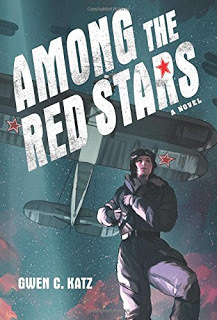 Almost five years ago (hard to believe it’s been that long!), I ran a blog series on the various roles that women held in the medieval and early modern world: Russia in particular, but also in the lands to the east, south, and west. The series started with “Women of Steel,” which looked at why I made my main Legends heroine, Nasan, a Tatar instead of a Russian and what life was like for the nomadic women of the Eurasian steppe. The series continued through July 2013, and if you’re interested in the topic, you can follow it backward from “Taking the Veil.” By August I was facing up to the demands of the then-new book, long since published, with a post on how to tackle the subject of “Men at War.”
Almost five years ago (hard to believe it’s been that long!), I ran a blog series on the various roles that women held in the medieval and early modern world: Russia in particular, but also in the lands to the east, south, and west. The series started with “Women of Steel,” which looked at why I made my main Legends heroine, Nasan, a Tatar instead of a Russian and what life was like for the nomadic women of the Eurasian steppe. The series continued through July 2013, and if you’re interested in the topic, you can follow it backward from “Taking the Veil.” By August I was facing up to the demands of the then-new book, long since published, with a post on how to tackle the subject of “Men at War.”So I was delighted to have a chance to interview Gwen Katz on New Books in Historical Fiction. We discuss her debut novel, Among the Red Stars, which looks at the women who flew for the Soviet Union as combat pilots. Through the lives of an appealing and courageous bomber pilot, her dedicated but (through no fault of her own) politically suspect navigator and cousin, and the pilot’s best friend, a young man drafted into the Red Army as a ham radio operator, we get a full and fascinating introduction to this little-known element of the Second World War: women who battled to take part in the fighting and men who would much rather have stayed home.
As always, the rest of this post comes from New Books in Historical Fiction.
Valentina (Valka) Koroleva and her cousin Iskra share a dream: to fly in defense of their Soviet motherland against the Nazi forces that have launched a surprise invasion in violation of Hitler’s nonaggression pact with Stalin. So when Valka receives a telegram announcing the formation of all-female fighting and bomber units, the two of them set off for Moscow without hesitation.
The number of applicants far exceeds the slots available, and the competition proves tougher than Valka and her cousin anticipate. But while they do not in the end become elite fighter pilots, they do make the cut for the night bomber unit: Valka as a pilot and Iskra as her navigator. Soon they are flying a shaky biplane constructed of wood and canvas, liable to burst into flames or crash without warning, against the German forces. Meanwhile, Valka’s best friend, Pasha, has been drafted into a ground regiment where he operates a ham radio under harsh conditions. He and Valka exchange regular letters, expressing their different experiences of war.
But fighting for the Soviet Union means coping not only with the enemy but also with Stalin’s paranoia. Iskra’s parents, arrested even before the war, cast a long shadow on her prospects for success despite her willingness to sacrifice her life for her country. Some of Valka’s assigned targets turn out to be people on her own side. Pilots shot down in combat or soldiers captured in an ambush are declared traitors to the state. And she learns that those in authority—or even comrades in arms—are at times the most likely to denounce those suspected of disloyalty, a category that includes insubordination. So although Among the Red Stars is listed as Young Adult, in fact Gwen Katz has written a novel that, because it tackles difficult problems with honesty, will appeal to adults as well. It is also a riveting tale about women in combat, female friendship, and survival against the odds.
And don’t forget to check out her website, linked in the paragraph above, where she has a collection of artworks linked to the book.
Published on February 09, 2018 06:00
February 2, 2018
Ever-Changing Algorithms
 I freely admit to struggling with social media. While I worked to master Facebook and Twitter, the world moved on to Instagram and Snapchat, which have since been replaced by a dozen other sites and apps that I can’t even name, let alone use. I abandoned my LinkedIn account years ago, although LinkedIn seems as unconvinced of that fact as Yahoo, which still sends me messages about security breaches demanding that I log in to my supposedly deleted account. And although I unreservedly love Pinterest, even it gets quirky at times, usually because the site owners have either decided that their users are desperate for more ads or because they’ve initiated an upgrade to something that worked just fine before they messed with it and has stopped working now.
I freely admit to struggling with social media. While I worked to master Facebook and Twitter, the world moved on to Instagram and Snapchat, which have since been replaced by a dozen other sites and apps that I can’t even name, let alone use. I abandoned my LinkedIn account years ago, although LinkedIn seems as unconvinced of that fact as Yahoo, which still sends me messages about security breaches demanding that I log in to my supposedly deleted account. And although I unreservedly love Pinterest, even it gets quirky at times, usually because the site owners have either decided that their users are desperate for more ads or because they’ve initiated an upgrade to something that worked just fine before they messed with it and has stopped working now.But no group of programmers loves to ring changes like the folks at Facebook. So it came as no surprise to discover, for the umpteenth time, that Facebook is altering its algorithms: this time, or so we’re told, to favor posts from friends and family at the cost of small businesses and publishers (unless they pay to promote their posts, presumably). According to the press release, this change is good for us, the users. And indeed, I would like to see posts from my close friends rather than click bait sent out by Russian bots. Wouldn’t you?
Only that doesn’t seem to be happening. My friend lists are still buried three layers deep at the side of the page, under News Feed, Messenger, Watch, Marketplace, Events, Groups, Fundraisers, and more. Not to mention Games (which I never play), On This Day (which is what?), and, of course, Ads Manager.
Now, the truth is that I don’t care all that much about having to search for posts from my friends. A lot of them do show up in my News Feed, and because I don’t respond to political news (I’m on social media as an author, after all, not a commentator), I see the bots only once in a while. And since I mostly get on Facebook, check notifications and messages, post on behalf of myself or Five Directions Press, and get off, I recognize that there may be ways to hide the Marketplace or the Fundraisers (although I couldn’t find a way to hide the Games) that I just don’t know.
But why punish small businesses that don’t have significant ad budgets? Is Facebook really in such desperate need of cash that it makes sense to disadvantage groups like the New Books Network, where a small army of volunteers produces interviews that range from public education to entertainment and which themselves run at a loss because they don’t charge their listeners?
Perhaps more fundamentally, why change a site just for the sake of change? One no sooner learns to navigate most social media than those in power introduce a new “feature” that, as often as not, upsets the apple cart for no obvious benefit.
Change is inevitable. We grow or we die. But it should be, when possible, purposeful. And call me naive or old-fashioned if you like, but surely making more and more money is not the only purpose worth serving. Especially if you do it while pretending you just want to bring people closer, even at some cost to yourself.
Published on February 02, 2018 06:00
January 26, 2018
Interview with Mimi Matthews
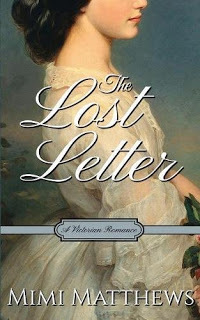 Those of you who follow Five Directions Press’s monthly Books We Loved posts—and if you are an avid reader, you really should, if you don’t already (you can find them all on our newsletter page)—may have noticed that my picks for January included both Bernard Cornwell’s
Fools and Mortals
and Mimi Matthews’
The Lost Letter
. You can find my Q&A with Bernard in a post a couple of weeks ago, and today I’m hosting a written interview with Mimi.
Those of you who follow Five Directions Press’s monthly Books We Loved posts—and if you are an avid reader, you really should, if you don’t already (you can find them all on our newsletter page)—may have noticed that my picks for January included both Bernard Cornwell’s
Fools and Mortals
and Mimi Matthews’
The Lost Letter
. You can find my Q&A with Bernard in a post a couple of weeks ago, and today I’m hosting a written interview with Mimi.Very different subjects, very different styles, but great writing is great writing. So if you have even a little bit of fondness in your heart for a touching love story set in Victorian times and with fully rounded characters, do check out Mimi Matthews’ novels (and nonfiction). Scroll down and you’ll find links to her website and social media accounts, where you can get more information.
And if it needs to be fast-paced thriller to keep your attention—although still with great writing and complex, compelling characters—then the links in the Bernard Cornwell interview will show you where to learn more about those.
You have a great interest in Victorian times, as evidenced by your nonfiction book The Pug That Bit Napoleon , among other works. Where did that interest originate, and which came first—the fascination with the Victorian period or the interest in writing fiction?
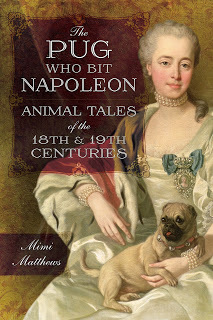 My interest in writing fiction definitely came first. I wrote my first full-length book (a YA novel) when I was thirteen and signed with my first literary agent when I was eighteen. After that, I was preoccupied with college, law school, and work and didn’t write any fiction until a few years ago, when I got the idea for a romance novel. I wrote it in a few months and then signed with a new literary agent. While it was out on submission, I wrote three more romance novels, including The Lost Letter and The Viscount and the Vicar's Daughter.
My interest in writing fiction definitely came first. I wrote my first full-length book (a YA novel) when I was thirteen and signed with my first literary agent when I was eighteen. After that, I was preoccupied with college, law school, and work and didn’t write any fiction until a few years ago, when I got the idea for a romance novel. I wrote it in a few months and then signed with a new literary agent. While it was out on submission, I wrote three more romance novels, including The Lost Letter and The Viscount and the Vicar's Daughter. As for the Victorian era, I’ve always been a fan. I read a lot of Charles Dickens and the Brontë sisters growing up and, in my third year of law school, I did a huge research paper on the British Court of Chancery. Since then, I’ve researched and written extensively on the Victorian era for my own website, as well as for other publications. In September 2016, I signed a multi-book deal with Pen and Sword Books (UK). My first nonfiction book with them, The Pug Who Bit Napoleon, came out in December. My next one, A Victorian Lady's Guide to Fashion and Beauty , will be out in July 2018.
Tell us about Sylvia Stafford, the heroine of The Lost Letter. Where is she, literally and emotionally, at the start of the book? At the beginning of the novel, Sylvia is employed as a governess in a merchant's household in Cheapside. It’s a far cry from the life she led as the privileged daughter of a wealthy baronet. But Sylvia is an intelligent, pragmatic sort of woman and has—for the most part—come to terms with her altered status in society. She’s even managed to find a measure of happiness in her work. Or so she believes. As the story progresses, it becomes clear that much of her heartache and disappointment is still unresolved. This is especially evident when she once again crosses paths with Sebastian.
And what of Sebastian Conrad, earl of Radcliffe? They have something of a past, but their reunion takes place under very different circumstances, for him as well as for her.Unlike Sylvia, Sebastian is not coping very well with his change in circumstance. The disfiguring injuries he suffered as a soldier in India both depress his spirits and cause him physical pain. He’s bitter and angry, raging at himself and everyone around him. When Sylvia makes an unexpected appearance at his country estate, he is anything but pleased. He had loved her once, and the sting of her rejection still rankles. Nevertheless, he makes an effort to see her and speak to her, even if only to show her how little he cares.
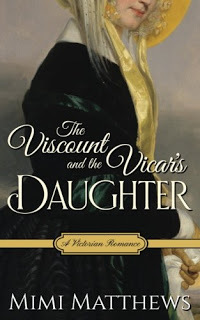 Your second novel,
The Viscount and the Vicar's Daughter
, came out this week. What can you tell readers about that book?After reading The Lost Letter, you may have guessed how much I enjoy playing with classic romance tropes. The Viscount and the Vicar’s Daughter is my go at the “reformed rake” trope. It features a disillusioned libertine with a scandalous past and an earnest vicar’s daughter with a few secrets of her own. It’s not as tortured a love story as The Lost Letter. I’d classify it more as a mid-Victorian romp. So far, advance reviews have been great. I’m really hoping readers will love it, too.
Your second novel,
The Viscount and the Vicar's Daughter
, came out this week. What can you tell readers about that book?After reading The Lost Letter, you may have guessed how much I enjoy playing with classic romance tropes. The Viscount and the Vicar’s Daughter is my go at the “reformed rake” trope. It features a disillusioned libertine with a scandalous past and an earnest vicar’s daughter with a few secrets of her own. It’s not as tortured a love story as The Lost Letter. I’d classify it more as a mid-Victorian romp. So far, advance reviews have been great. I’m really hoping readers will love it, too.In the back of The Viscount and the Vicar’s Daughter, there is an excerpt from a third novel, The Advertisement (which I for one can’t wait to read, because the setup is great), due out this summer. Is that book already done? And if so, what are you working on now?I’m so glad you enjoyed the excerpt! The Advertisement is almost done. It’s due to my editor at the end of March. It’s much longer than my previous two Victorian romances and the subject matter is a bit heavier as well. It focuses on two real—and very grim—events from the late 1850s. As for the central romance, it’s poignant, passionate, and exceedingly angst-ridden. So far, reports from my beta readers have been really positive. We’ll see what my editor thinks!
Next, I’m working on a Victorian Christmas novella about a broken betrothal and (possible) breach of contract suit. It will be out in November 2018.
Thanks so much for answering my questions, Mimi. I wish you all success with both your novels and your nonfiction works!
 Mimi Matthews writes both historical nonfiction and traditional historical romances set in Victorian England. Her articles on nineteenth-century history have been published on various academic and history sites, including the Victorian Web and the Journal of Victorian Culture, and are syndicated weekly at BUST Magazine. In her other life, Mimi is an attorney with both a Juris Doctor and a Bachelor of Arts in English Literature. She resides in California with her family, which includes an Andalusian dressage horse, two Shelties, and two Siamese cats.
Mimi Matthews writes both historical nonfiction and traditional historical romances set in Victorian England. Her articles on nineteenth-century history have been published on various academic and history sites, including the Victorian Web and the Journal of Victorian Culture, and are syndicated weekly at BUST Magazine. In her other life, Mimi is an attorney with both a Juris Doctor and a Bachelor of Arts in English Literature. She resides in California with her family, which includes an Andalusian dressage horse, two Shelties, and two Siamese cats.Find out more about Mimi at the links below.
Website: https://www.mimimatthews.com/
Facebook: https://www.facebook.com/MimiMatthewsAuthor/
Twitter: https://twitter.com/MimiMatthewsEsq
Published on January 26, 2018 06:00
January 19, 2018
Finding That Perfect Read
 One advantage of the current publishing climate is that a reader has no shortage of books from which to choose. Free and low-cost books are everywhere, including through subscription services like Amazon.com’s Kindle Unlimited. But finding a good book is not so easy. Reviews offer some insight, but many good books fail to attract reviews for various reasons. Book bloggers soon acquire more titles than they can ever have time to read, never mind write about. Readers, too, become overwhelmed by demands on their time. And not all reviews are what they seem: ethical writers, including myself, refuse to pay for book reviews, but some desperate souls give way to temptation. So what’s a reader to do?
One advantage of the current publishing climate is that a reader has no shortage of books from which to choose. Free and low-cost books are everywhere, including through subscription services like Amazon.com’s Kindle Unlimited. But finding a good book is not so easy. Reviews offer some insight, but many good books fail to attract reviews for various reasons. Book bloggers soon acquire more titles than they can ever have time to read, never mind write about. Readers, too, become overwhelmed by demands on their time. And not all reviews are what they seem: ethical writers, including myself, refuse to pay for book reviews, but some desperate souls give way to temptation. So what’s a reader to do?One approach, adopted by more than a few GoodReads friends I know, is to limit oneself to commercially published books. There readers can trust that books have gone through editing, typesetting, and proofreading, received professional covers—and, yes, that any reviews they receive reflect the honest opinion of the reviewer. But trade books are expensive, at $9.99–$12.99 or more even for an e-book. For the average voracious reader, they represent at best a partial solution, although public libraries can help.
That approach also ignores the many good books published outside the commercial houses. And commercial publishing is just that: books have to sell millions of copies in today’s market to make a trade publisher’s investment worthwhile. If your taste runs to more unconventional fare, you’re out of luck.
That’s where small presses and coop publishers (a variant on small presses) come in. A coop like Triskele Books or my own Five Directions Press exerts the quality control of a traditional publishing house but can charge less, especially for e-books, because the coop authors can break even at a much lower number of copies sold. No one can guarantee that if you love one author’s gritty historical fantasy, you will love another’s sparkling contemporary romance, but you can count on each book having received extensive critique and suggestions for improvement followed by professional editing, typesetting, proofreading, e-book production, and cover design. We guarantee one another’s work.
We also cooperate to get the word out, which means that we publish newsletters featuring other authors and news about our forthcoming titles, regular lists of book recommendations—such as Triskele’s Book Muse and Five Directions Press’s monthly Books We Loved—and blog posts, many of which feature writers and/or their books. I host an interview channel, New Books in Historical Fiction, where I interview other authors and read excerpts from their books. Gabrielle Mathieu, another Five Directions Press author, does the same for fantasy and adventure novels.
So you see, there are tools out there to help you navigate the independent publishing ocean. Take a chance! You never know what magical island may be hiding right over that cloudy horizon.
An earlier version of this post appeared on the Triskele Books blog a few weeks ago. Many thanks to all the Triskele authors for the opportunity to share my thoughts with their readers!
Image: Clipart 109839003.
Published on January 19, 2018 06:00
January 12, 2018
Interview with Bernard Cornwell
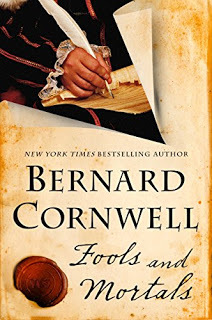 One of the great pleasures of hosting New Books in Historical Fiction has been having the opportunity to make the acquaintance of Bernard Cornwell, the bestselling author of The Last Kingdom series—now an ongoing TV production as well—and many other novels, including series set during the Hundred Years War and the Napoleonic Wars.
One of the great pleasures of hosting New Books in Historical Fiction has been having the opportunity to make the acquaintance of Bernard Cornwell, the bestselling author of The Last Kingdom series—now an ongoing TV production as well—and many other novels, including series set during the Hundred Years War and the Napoleonic Wars. When I learned that Bernard had produced a one-off novel about the life of William Shakespeare and the theater culture in which Shakespeare played such an important role, I offered a choice of a written or telephone interview, to run concurrently with the release of the novel, Fools and Mortals , in the United States on January 9, 2018.
In the end, we settled on a written Q&A, which I reproduce here. My questions are in bold, and Bernard’s answers follow. Thank you so much to Bernard for his fascinating and informative answers, and don’t forget to check out his official website for more information on this novel, his other books, the television programs, and events. And read the book, of course!
Fools and Mortals is something of a departure for you. No military heroes, no battles, no Agincourt or Napoleonic Wars or Saxons vs. Danes. What made you decide to write a novel about William Shakespeare?I suppose the short answer is a fascination with Shakespeare. The longer answer is that a dozen years ago I got involved with a summer-stock theater on Cape Cod—the Monomoy Theatre—and ever since have (mis)spent my summers on stage. The theater exists to give drama students from all across America the chance to experience a season of musicals and plays, eight productions in ten weeks, in front of a paying audience . . . the “grown-up” parts and the directors are all Equity professionals, but spear-carriers etc can be drawn from local people, which is how I got involved, except they seemed to quite like me so that over the years I’ve played Toby Belch, Friar Laurence, Henry IV, Peter Quince (twice) and, most memorably, Prospero. I’ve also danced and sung solos (dear God), and been in plays by Chekhov, Neil Simon, Arthur Miller and the wonderful Ken Ludwig. I’d never been on stage before and the experience has intrigued and fascinated me, and really gave rise to a novel about putting on a play!
The protagonist narrating the story is Richard Shakespeare, William’s younger brother. I confess I have no idea whether William had a younger brother, but it’s a great way to showcase a celebrity while maintaining your freedom as an author. Who is Richard, as a character? What does he want most out of life?Shakespeare had three brothers! Giles, Edmund and Richard. We know something, not much, about the first two (Edmund became an actor, probably in his brother’s company, and died young. He’s buried in Southwark Cathedral), but we know virtually nothing about Richard, other than a parish record of his christening and another of his death. So he’s a wonderful character for an historical novelist! He really existed and we know nothing about him. I decided to invent a theatrical career for him because it gave him access to his brother, but also to make the relationship somewhat hostile because that kept William at arm’s length (and saved me from the hubris of inventing too much dialog for William Shakespeare, really!). Richard is a young man who wants what many young men want, success and a girl, and he doesn’t quite know how to get either, and he’s also stage-struck. He happens to be good-looking and he has natural talent, but he’s still going to need what all actors need—a little bit of luck!
Richard has at best an adversarial relationship with his older brother, who comes across as demanding, difficult, even somewhat rejecting and mean. This portrayal reflects, of course, Richard’s point of view. What made you decide to present them in this way?I don’t think William is mean! He’s not too fond of his brother because Richard reminds him of Stratford and William has a decidedly mixed view of Stratford. On the one hand it’s where he began, where he probably did not enjoy much success, where his ambitions far exceeded his apparent opportunities, and where, in all probability, he contracted a less than satisfactory marriage. All of this, of course, is supposition based on slender evidence, but novelists thrive on such hints. Yet Stratford is also home and we know he invested heavily in land about the town and eventually built the second largest house there (New Place). That suggests he would only return to Stratford on his own terms, not as the son of John Shakespeare, a failed merchant, but as a very wealthy, prominent and influential citizen. Richard is a reminder of what he fled, and Richard is also a nuisance, wanting favors. William doesn’t need Richard, but Richard needs William, and William really doesn’t want the distraction. He’s a busy man! Entrepreneur, writer, actor, probably director, and the presence of a younger brother is an annoying distraction.
In Elizabethan England women could not play on the stage (the movie Shakespeare in Love’s contrary portrayal notwithstanding). So part of the animosity between the brothers comes about because Richard wants to stop playing women’s parts and move into men’s roles, especially after he falls in love. Why is Will so reluctant to allow this change?Because the company doesn’t need another man! Actors, as a couple of the characters say in the book, are ten a penny (they still are). The Sharers, the owners of the company, all must have a part in any play and then there are a half dozen regular “Hired Men” who are paid a wage when they are needed, and after that come the apprentices, the boys who play women’s roles, pages and children. Richard is cheap to employ as an apprentice, but once he’s outgrown the roles of young women he’s just another freelance actor . . . of whom there are plenty. Basically he’s just another Hired Man and the Lord Chamberlain’s company already had plenty of those available. I don’t think Will is reluctant so much as he doesn’t see the need to encourage another hungry mouth around a theater already supplied with too many.
Specifically, Fools and Mortals revolves around the first staging of A Midsummer Night’s Dream and the writing of Romeo and Juliet. Why did you pick this period as the setting for your novel?Probably the most fascinating thing about the period is that it sees the establishment of a professional theater industry—as we know it today. Before the 1570s there were no permanent playhouses. There were plays and players, but they were all peripatetic . . . traveling around the country giving performances in inn yards or wherever else they could. Now the key thing there is that your audience on Monday afternoon in Stratford will not be the same as the audience in Warwick on Wednesday, so you can do the same play, over and over, in different towns, fairly sure that the play will be new to the audience. That means you need very few plays in your repertoire. But then some genius hits on the idea of building a permanent playhouse, a theater. The only city in Britain capable of supporting a playhouse was London and, in short order, there were two such theaters. Now there’s a new problem. The audience is drawn from the same population day after day, week after week, month after month, so you need a lot of new material. Whereas the old traveling companies could probably survive on a half dozen plays, the new permanent companies found themselves producing thirty plus plays a year. You need new plays all the time, and that means you need playwrights! A new profession sprang up overnight, as did the idea of a permanent theater. It’s an amazing development, and one that was immediately successful and, like any emerging industry finding its way, there’s an excitement to the process.
One of the plot lines involves the theft of plays by a rival playhouse. I found this fascinating, especially since it’s implied that it was not uncommon in Shakespeare’s day. Do tell us more about that element of the story. The playwrights of the 16th century did not enjoy the protection of copyright! It’s that simple. If the script of a play fell into the hands of a rival company, then there was no law to prevent them staging the play and, of course, paying no fee to the playwright. And plays were valuable! The audience was always eager for new material, so the companies guarded their scripts jealously. They did publish some, but only after they had exhausted the chances to perform the play. That’s how we have Shakespeare’s quartos . . . they were published once the company had decided there was nothing more to be squeezed out of them on stage, and of course, the sales of the books provided extra income, especially welcome when the playhouses were closed because of plague. It was probably very uncommon for a really valuable play to be stolen, but the fear of that happening was very real.
Richard also falls foul of the Pursuivants, known to the players as the Percies. Who are the Percies, and what do their activities reveal about the position of the theater in Shakespeare’s day?Probably nothing! The Pursuivants existed to hunt down Catholics, and that has a great deal more to do with the Pope’s foolish bull that offered heavenly bliss to anyone who succeeded in assassinating Queen Elizabeth. That civil strife grumbles on throughout Elizabeth’s reign, a constant battle between Catholic plotters who wanted to replace Elizabeth with a Roman Catholic monarch and the secret service that combated them, and punished them horribly. The real enemy of the theater was the Puritans, who utterly disapproved of plays and players and who campaigned tirelessly to close down the theaters. In the end, 1642, they were successful, though happily their rule in England was mercifully brief and the theaters reopened in 1660 and have thrived ever since. Richard’s brush with Pursuivants is incidental: they believed, erroneously, that the Theatre (Shakespeare’s playhouse) was a den of secret Catholic sympathizers. They were certainly dangerous and merciless enemies, but they were also loyal to Elizabeth who, we know, was a lover of the theater.
There are some wonderful passages in the novel about writing and the stage. One of my favorites comes on p. 247, where Richard says, “We are players, and we love an audience. Sometimes, if a play is going badly, it is easy to think of the audience as an enemy, but truly they are a part of the play, because an audience changes the way we perform.” I know you act in repertory theater during the summers, and I think anyone who has taken part in a live performance recognizes how the presence of the audience imparts an energy that rehearsal simply doesn’t. We writers don’t interact with our readers that way. As someone who does both, how does that difference change things? Do you prefer one type of interaction over the other, and if so, why?
 Bernard Cornwell as Prospero
Bernard Cornwell as Prospero© Michael & Suz KarchmerOh good Lord! I’m not frightened of writing (maybe I should be!), but going on stage is terrifying. Every year I wonder why I do it. I could spend my summers lollygagging on my sailboat, walking the dog, or extending my encyclopedic knowledge of Irish whiskies, but instead I have to learn lines, spend hours in rehearsal, act on a stage which isn’t touched by the theater’s air-conditioning in costumes designed for a Siberian winter, and risk making a complete fool of myself.
But then comes the performance and . . .
Yes, there’s a rush of adrenaline, the challenge of doing something which I never imagined I would ever do and the knowledge that I will probably never master it. I’m totally confident sailing a boat, I’ve crossed the Atlantic under sail, I seem to be doing all right as an author, but as an actor? Dear God, it challenges and frightens me. I must be reasonably good or they wouldn’t give me parts like Prospero, but I don’t know that. And yes, the reward is not just the applause . . . though of course that’s delicious, but the best is utter silence. This year I got the most applause (cheaply) dressed full-fig as a bishop, mitre and all, crossing the stage and singing, “I wanna be loved by you, by nobody else but you,” but that, wonderful as it was (exit applause! Yay!) was nothing to sensing the audience’s utter stillness during “Our revels now are ended.”
Which do I prefer? I love both. Must I choose?

Bernard Cornwell is the author of more than forty-five novels and one nonfiction book, Waterloo: The History of Four Days, Three Armies, and Three Battles (2014). His Last Kingdom and Sharpe series have also been turned into hit television programs. He lives in South Carolina with his wife, Judy, whom he married in 1980, and spends his summers acting in repertory theater on Cape Cod, Massachusetts, among other pursuits. Learn more about the topics he discusses here in his 2014 and 2016 interviews at New Books in Historical Fiction.
Published on January 12, 2018 06:00
January 5, 2018
Looking Forward to 2018
 The first week in January, everyone has plans for self-improvement, or at least tasks they would like to complete in the new year. I’m no exception to this trend.
The first week in January, everyone has plans for self-improvement, or at least tasks they would like to complete in the new year. I’m no exception to this trend. So, in addition to the usual—ditching the four pounds that attached themselves to my waistline between Thanksgiving and Christmas (blame the breakfast bagels and desserts), maintaining a regular exercise program, getting lots of sleep, drinking plenty of plain water, reading some of those books on my “never quite got to them” list, etc.—here are my writing and publishing goals for 2018:
(1) completing my Legends of the Five Directions series with the publication of The Shattered Drum;
(2) producing a rough draft for Song of the Siren, first in my new, probably four-part series—also set in Russia and the neighboring lands but in the 1540s—which explores individual women’s lives, told in the first person, mostly outside the traditional boundaries of marriage and motherhood;
(3) conducting twelve New Books in Historical Fiction interviews;
(4) typesetting/proofing, producing e-books, and in some cases editing the Five Directions Press titles scheduled for 2018—Chains of Silver, The Falcon Soars, The Shattered Drum, and A Holiday Gift, more or less in that order;
(5) maintaining my website and the Five Directions Press website—which means keeping track of the “Books We Loved” posts, expanding the number of authors and titles available, and keeping the news & events page up to date;
(6) posting to this blog every Friday; and
(7) staying active on social media as a way of connecting with and supporting other writers, especially the authors associated with Five Directions Press, as well as reaching readers.
As always, you can check back in December to see how I did. I should be okay, as these are pretty modest goals. No three-hundred-book reading challenges or doubling my number of interviews or aiming to write four books a year in the mix. Most of them are things I’m doing anyway, or have to do if I want to see sales for my books. But that’s the secret of keeping resolutions, right? Cut them down to size, make them essential, and the chances of meeting one’s goals leap dramatically.
The holidays are over, the tree and outside decorations will soon be memory (although the weather looks to remain frosty for a while), and alas, my lovely writing vacation is over. But I still wish everyone a splendid new year, with love and success and happiness galore!
In other news, you can find my suggestions on how to find great books to read (especially helpful if you just received an e-reader or gift card as a holiday gift) on the Triskele Books blog. And make sure to stop by next Friday, when I will be hosting a written interview with Bernard Cornwell about his latest novel, Fools and Mortals.
Image: Clipart.com no. 109382488.
Published on January 05, 2018 06:00
December 29, 2017
2017 Revisited
At this time of year, although I eschew formal New Year’s resolutions about losing weight or exercising more, I do like to conduct a brief review of what I planned for the year and define a new set of expectations for the year to come.
For 2017, I had the following goals:
(1) completing The Vermilion Bird and seeing it in print;
(2) starting The Shattered Drum, the last of my Legends of the Five Directions although I also plan a spinoff series set in Russia around the same time;
(3) conducting twelve New Books in Historical Fiction interviews;
(4) typesetting/proofing, producing e-books, and in some cases editing the Five Directions Press titles scheduled for 2017—Rewind, West End Quartet, The Falcon Strikes, The Vermilion Bird, and A Holiday Gift, more or less in that order;
(5) maintaining my website and the Five Directions Press website—which means keeping track of the “Books We Loved” posts, expanding the number of authors and titles available, and keeping the news & events page up to date;
(6) posting to this blog every Friday;
(7) maintaining and strengthening my relationships with fellow writers; and
(8) continuing to improve my grasp of marketing, on both my own behalf and that of Five Directions Press—including finding more ways to get reviews.
I actually did pretty well this year. I finished The Vermilion Bird as planned, and Five Directions Press published it in December 2017. I also finished The Shattered Drum—a surprise—except for one set of comments from my writers’ group. Once those come in, I’ll do another revision and read-through, then off it goes to typesetting. Most likely it will appear in print and e-book sometime between May and September 2018, depending on what else we have in the pipeline. And I have begun work on Song of the Siren, set in 1541–1542 and the first book in my new Russian series, Songs of Steppe and Forest. Siren has a long way to go: right now it is a full set of story events and main character profiles plus about two serviceable chapters and some scenes, but with luck, it will reach first draft status sometime in 2018.
So much for my own work. Five Directions Press did bring out five books, although The Duel for Consuelo replaced A Holiday Gift, which will come out next year. I did conduct a full set of interviews, from Helen Rappaport talking about her companion volume to the PBS miniseries Victoria, now entering season 2, in January to Heather Webb discussing her Last Christmas in Paris, co-authored with Hazel Gaynor, in December. In between we traveled to the US South, Shakespearean England, early twentieth-century Egypt, World Wars I and II, and Viking-era Norway, as well as other times and places. My thanks to all the authors who spoke with me, and I’m looking forward to a new crop of guests next year.
In web-related things, I did manage to maintain my blog schedule and stay up-to-date on the Five Directions Press site; I even updated my own site for the release of Vermilion Bird, although it lay pretty dormant until then. I did my bit on social media, including running two book teaser campaigns (the second still underway) for Five Directions Press and lurking in various GoodReads groups whenever possible. So between that and the interviews I can claim to have done reasonably well on Goal 7. As for marketing, I’m not sure I will ever really get a hold on it, especially since the techniques that work seem to change without warning every few months. But my limitations in that area aren’t for lack of trying, more a result of having only so many hours in the day.
Check back next week, and I’ll have a new list of goals for 2018. Meanwhile, I wish you all a safe and joyous New Year!

Image: Clipart no. 110076193.
For 2017, I had the following goals:
(1) completing The Vermilion Bird and seeing it in print;
(2) starting The Shattered Drum, the last of my Legends of the Five Directions although I also plan a spinoff series set in Russia around the same time;
(3) conducting twelve New Books in Historical Fiction interviews;
(4) typesetting/proofing, producing e-books, and in some cases editing the Five Directions Press titles scheduled for 2017—Rewind, West End Quartet, The Falcon Strikes, The Vermilion Bird, and A Holiday Gift, more or less in that order;
(5) maintaining my website and the Five Directions Press website—which means keeping track of the “Books We Loved” posts, expanding the number of authors and titles available, and keeping the news & events page up to date;
(6) posting to this blog every Friday;
(7) maintaining and strengthening my relationships with fellow writers; and
(8) continuing to improve my grasp of marketing, on both my own behalf and that of Five Directions Press—including finding more ways to get reviews.
I actually did pretty well this year. I finished The Vermilion Bird as planned, and Five Directions Press published it in December 2017. I also finished The Shattered Drum—a surprise—except for one set of comments from my writers’ group. Once those come in, I’ll do another revision and read-through, then off it goes to typesetting. Most likely it will appear in print and e-book sometime between May and September 2018, depending on what else we have in the pipeline. And I have begun work on Song of the Siren, set in 1541–1542 and the first book in my new Russian series, Songs of Steppe and Forest. Siren has a long way to go: right now it is a full set of story events and main character profiles plus about two serviceable chapters and some scenes, but with luck, it will reach first draft status sometime in 2018.
So much for my own work. Five Directions Press did bring out five books, although The Duel for Consuelo replaced A Holiday Gift, which will come out next year. I did conduct a full set of interviews, from Helen Rappaport talking about her companion volume to the PBS miniseries Victoria, now entering season 2, in January to Heather Webb discussing her Last Christmas in Paris, co-authored with Hazel Gaynor, in December. In between we traveled to the US South, Shakespearean England, early twentieth-century Egypt, World Wars I and II, and Viking-era Norway, as well as other times and places. My thanks to all the authors who spoke with me, and I’m looking forward to a new crop of guests next year.
In web-related things, I did manage to maintain my blog schedule and stay up-to-date on the Five Directions Press site; I even updated my own site for the release of Vermilion Bird, although it lay pretty dormant until then. I did my bit on social media, including running two book teaser campaigns (the second still underway) for Five Directions Press and lurking in various GoodReads groups whenever possible. So between that and the interviews I can claim to have done reasonably well on Goal 7. As for marketing, I’m not sure I will ever really get a hold on it, especially since the techniques that work seem to change without warning every few months. But my limitations in that area aren’t for lack of trying, more a result of having only so many hours in the day.
Check back next week, and I’ll have a new list of goals for 2018. Meanwhile, I wish you all a safe and joyous New Year!

Image: Clipart no. 110076193.
Published on December 29, 2017 06:00
December 22, 2017
Letters from a Friend
 In the twenty-plus years that I’ve been writing fiction, I can’t say it ever occurred to me to co-write a novel. If I’d stopped to think about it, I probably would have decided that it sounded more difficult than writing alone. Sharing the authorship of an academic article is hard enough, but at least two people can discuss the evidence and the argument and, with luck, agree on who has a more fluid pen and who a better grasp of statistics (or paleography or whatever your particular auxiliary discipline happens to be). But how do you share a sense of character or writerly style?
In the twenty-plus years that I’ve been writing fiction, I can’t say it ever occurred to me to co-write a novel. If I’d stopped to think about it, I probably would have decided that it sounded more difficult than writing alone. Sharing the authorship of an academic article is hard enough, but at least two people can discuss the evidence and the argument and, with luck, agree on who has a more fluid pen and who a better grasp of statistics (or paleography or whatever your particular auxiliary discipline happens to be). But how do you share a sense of character or writerly style?I’m not talking about critique groups here. As anyone who has followed this blog for even a dozen or so posts knows, I credit my writers’ group with getting me past the “reading books about fiction without really absorbing the information” stage and into the “here’s how you craft a story” stage. It’s no accident that I thank them lavishly at the end of each book: I truly don’t know how I would produce a finished product that made me proud to share it with the world unless it had first profited from their questions and comments.
Nor am I talking about the kind of co-writing that Joan Hess did for Elizabeth Peters by finishing Peters’ novel for her after Peters passed on, as she described in my September interview. Again, that’s a single writer’s vision replaced by a slightly different one that tries to honor the first—a complicated task, to be sure, even without the emotional trauma of performing such a service for a friend, but still one person at a time.
But as Heather Webb explains in this December conversation, it is possible for two writers to cooperate from beginning to end on a work of fiction. This lovely epistolary novel, set mostly during World War I but with a frame story in the late 1960s, grew out of a previous project and took shape through a prolonged Internet exchange that bound not only the characters but the authors in a deep and engaging friendship. For how that happened, listen to the interview.
And while you’re there, please don’t forget to support the New Books Network, so that the interviews on this and many other subjects can continue to enrich your lives. I give my time and the use of my equipment for free, but I nonetheless pledged to support the service. I look forward to hosting many more conversations with authors, whether they write alone or together. But we can keep the podcasts going only if everyone chips in.
As always, the rest of this post comes from New Books in Historical Fiction.
When we first meet Thomas Harding in 1968, he is facing what he believes will be his last Christmas and mourning the loss of an unnamed woman who clearly meant a great deal to him. He carries with him bundles of letters, which he plans to re-read on his trip to Paris. The letters sweep us back to the very beginning of World War I, then trace the entire course of the conflict. One of them he has not yet seen.
Most of the correspondence takes place between Thomas and Evie Elliott, the younger sister of his best friend, Will. We see the early hope and idealism of the troops fade as the realities of trench warfare sink in. We watch from the inside the transformation of women’s roles in society because of the absence of men. We become caught up in the developing love between Evie and Thomas, the grief suffered by families who lose their loved ones to war, the frustration of being left behind, unable to take part. We revel in the guilty pleasure of riffling through other people’s things, reading words not meant for our eyes.
Other voices fill in circumstances that Evie and Thomas take for granted or have no reason to know. And the drama slowly builds as Armistice Day approaches, and the war that was supposed to end all wars creeps to a close. The letters are vivid and real, each voice distinct. And by the end of Last Christmas in Paris , Hazel Gaynor and Heather Webb have shepherded us along a journey through the tragedy of war and the triumph of survival, the experience of love lost and gained.
And for those of you who celebrate, the time is here!
 Image: Clipart no. 110057306
Image: Clipart no. 110057306
Published on December 22, 2017 06:00
December 15, 2017
Life on the Island

If you follow me on social media, you may have noticed I’ve been pretty quiet this week. This post explains why.
Although one subject of this blog is technology and the writer’s life, I actually spend little time talking about technology. There’s a simple reason for that: how much technology does an author actually need? A computer and word-processing program, a browser and a search engine for those quick answers, maybe a novel-writing program to handle the organization and create e-books—that about covers it, unless you want to self-publish, in which case you must also be able to produce decently formatted files. These basic needs don’t require a lot of mastery or discussion.
But as I (re)discovered this week, these days for most of these basic things to work, you also need Internet access. For at least four of the last ten days, my Internet connection has been down for hours at a time. Some of the resulting problems were immediate and obvious. My work requires a lot of e-mail messages, and I could neither send nor receive them. I have to track tasks in an online database that I could not update. I keep important files on Dropbox, but the system had no way to record changes or sync edited files between my computer and my tablet. I had to reschedule my current interview for New Books in Historical Fiction three times. The book teasers I routinely add to the Five Directions Press Facebook and Twitter pages of necessity languished in obscurity.
I have a cell phone, from which I could send emergency messages—and not receiving constant streams of e-mail does have its advantages, although somehow the “buy this NOW” messages managed to reach my phone every two minutes regardless. And since I’ve refused to adopt software that exists entirely in the cloud, the damage wasn’t as severe as it could have been. I could still work and write and prepare this blog post—even though publishing the post would, of course, have been impossible.
But the glitches that really threw me were the ones I didn’t expect. Word had no record of my recent files, which it apparently stores somewhere other than my computer. The edits I made to The Shattered Drum did not transfer to iBooks even when I plugged in my tablet. The text message I sent from my phone registered, but the answering texts from my friend remained in the ether until my Internet connection revived, even though the replies were sent hours earlier to a phone that was supposedly on the 4G network, not the wireless one that connected to the nonfunctioning modem. Even people who did have working connections could not upload files to shared Dropbox folders that I would then see when my access returned.
And as a result of the lost connection, I couldn’t distribute the press release for my new book, The Vermilion Bird, even though I’d managed to create it in my old, non-cloud version of InDesign. So after going to a ton of effort to see the book in print by early December, in time for the holiday gift-giving season, I didn’t have a chance to tell anyone by e-mail or follow up on social media until the middle of the month. On a list of inconveniences this one barely merits a mention, but I found it mildly distressing even so.
That said, the story has a happy ending: the cable technician showed up this morning and, through a happy fluke, at once identified the problem: a cable that a careless leaf raker had managed to cut, not through but just enough to make the service unpredictable. The tech replaced the cable, and voila! The pluses and minuses of twenty-first-century life as a writer and editor returned full force. And the much-delayed interview with my incredibly patient guest went off beautifully. Meanwhile, I’ve acquired a whole new appreciation of the gifts the Internet brings to my life.
 Best wishes for a wonderful holiday season to all my readers. And if you’re looking for that last-minute present for a lover of historical fiction, set in a place a bit outside the mainstream, don’t forget the Legends of the Five Directions—especially
The Vermilion Bird
.
Best wishes for a wonderful holiday season to all my readers. And if you’re looking for that last-minute present for a lover of historical fiction, set in a place a bit outside the mainstream, don’t forget the Legends of the Five Directions—especially
The Vermilion Bird
.Images from Clipart.com, nos. 109097555 and 110053976.
Published on December 15, 2017 06:00
December 8, 2017
And Then There Were Four
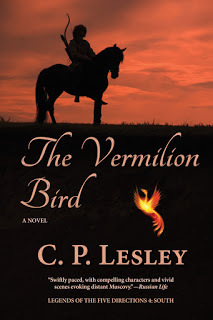 If you follow me on social media or even read this blog regularly, you’ll know that as of this week The Vermilion Bird (Legends of the Five Directions 4: South) has seen the light of day. As of a few hours ago, Amazon.com had still not linked the print and e-book editions, but if they don’t do it on their own in the next twenty-four hours, I will send a message to the support services. They’ve always proven themselves prompt and efficient in the past, so I’m sure it will soon be taken care of.
If you follow me on social media or even read this blog regularly, you’ll know that as of this week The Vermilion Bird (Legends of the Five Directions 4: South) has seen the light of day. As of a few hours ago, Amazon.com had still not linked the print and e-book editions, but if they don’t do it on their own in the next twenty-four hours, I will send a message to the support services. They’ve always proven themselves prompt and efficient in the past, so I’m sure it will soon be taken care of.The release of a new book is always exciting for an author. A published book has the heft of reality in a way that an electronic manuscript can’t match—even in the days of e-readers and tablets, which do let a writer read her own work in a format indistinguishable from e-books put out by a press.
Writers hope that the release of a new novel in a series is equally exciting for our readers. I know it is for me: I love it when I discover that one of my favorite characters has a new adventure for me to share.
But before I get to excerpts and reactions from readers to the latest Legends novel, let me remind you that until Sunday, December 10, the e-version of The Swan Princess is on sale for $2.99. This will certainly be the last promotion I run for some time—and given the poor results so far, even with paid Facebook ads, perhaps the last for a long time.
 Also, a quick word about the New Books Network (NBN), the parent organization that hosts my interviews on New Books in Historical Fiction. The nonprofit NBN runs entirely on volunteers who supply their own equipment and record on their own time, but the costs of managing the website and storing the 4,200 interviews that already exist—the NBN adds 100 a month and now serves 25,000 listeners a day—are considerable. On the plus side, the network is growing in popularity; on the minus side, the costs increase as more people listen in. To close the gap, the NBN is currently running a donations campaign through Amherst College. You can help by clicking this link and donating whatever amount you can afford. As with all donations to nonprofits, your contribution is tax-deductible. And you will earn the undying gratitude of every one of the 220 hosts. We all love what we do and want only to continue producing more interviews for you to hear.
Also, a quick word about the New Books Network (NBN), the parent organization that hosts my interviews on New Books in Historical Fiction. The nonprofit NBN runs entirely on volunteers who supply their own equipment and record on their own time, but the costs of managing the website and storing the 4,200 interviews that already exist—the NBN adds 100 a month and now serves 25,000 listeners a day—are considerable. On the plus side, the network is growing in popularity; on the minus side, the costs increase as more people listen in. To close the gap, the NBN is currently running a donations campaign through Amherst College. You can help by clicking this link and donating whatever amount you can afford. As with all donations to nonprofits, your contribution is tax-deductible. And you will earn the undying gratitude of every one of the 220 hosts. We all love what we do and want only to continue producing more interviews for you to hear.And now, a short excerpt from The Vermilion Bird, followed by a couple of early responses (and don’t forget to check out those authors’ books, too!).

Moscow, February 1537
“It’s a scandal, I tell you. Fyodor has gone mad.” Over the plink-plink of psalteries, the chatter of fifty women, the murmurs of servants in corners, and the noise from the courtyard below, Aunt Theodosia’s voice soared like a song. “Marrying a hussy two years older than his own daughter? Then wedding his own girl to his new wife’s former lover? Abominable! Where is his honor?”
“Auntie! How can you?” Maria, tempted to shrink into herself like a tortoise into its shell, instead gripped the hand of the hated Roxelana, whose fingers returned the favor with equal strength. “Stop squeezing me,” she hissed at her stepmother, who narrowed her eyes and hissed wordlessly back.
But Roxelana, although a general irritant, bore no responsibility for Maria’s present agony. On the contrary, she shared it. Must Auntie announce their predicament to the world? Thanks to her, every woman here knew—now, if she hadn’t before—that Roxelana had lived for years with the man destined to become Maria’s husband tomorrow, only to abandon him for Maria’s father and the respectability he offered.
A hint of sandalwood and cinnamon released into the air as Roxelana shifted in her seat. Among the many perfumes wafting around the room, hers stood out: seductive, elusive, foreign.
Respectability? Roxelana? As if that’s not a contradiction in terms!
Aunt Theodosia was still talking—bellowing, rather, with the blissful unconcern of the hard of hearing. “Twenty-two years old, and him a ripe thirty-seven. What does he want with a lovely nincompoop to warm his bed? After wearing my dearest sister to the bone, bearing and raising his children. Thirteen she gave him. Thirteen. And seven who lived!”
“We know, Auntie. We can count.” This voice, young and sweet, belonged to Maria’s sister Varvara, second of the seven living offspring. She spoke in softer tones than Theodosia.
“Don’t mumble like that, girl,” Theodosia snapped. “Speak up.”
“Hush now.” Varvara raised her voice as commanded. “The whole room can hear you.” She gestured with her right hand. “Including our stepmother.”
“Don’t be absurd. I’m whispering, just as you are,” Theodosia said at top volume. “Stepmother, indeed. Harlot, more like.”
Roxelana hissed again, louder this time, and Varvara pressed her lips together, as if trying not to giggle. In response Theodosia fixed Roxelana with her basilisk glare. “Ridiculous. Just ridiculous.”
“You’re being rude, Auntie,” Maria said. Anything to deflect the discussion to another channel, although she agreed with Theodosia. Watching Papa glow like a schoolboy while her stepmother flirted and cooed left her two steps short of disgust. Parents were not supposed to act like that.
As for this new match with her stepmother’s discarded lover, Theodosia was right: Papa had lost his mind. A man nine years older than Maria, and a Tatar—what would they talk about?
“The Vermilion Bird vividly envisions the culture clash between Russians and Tatars in the sixteenth century. Fans of historical fiction will enjoy this glimpse into a seldom explored corner of history, while fans of romance will delight in the unlikely love that blooms between a bluff Tatar prince and his scheming Russian bride—who is also the stepdaughter of his former lover.”—Linnea Hartsuyker, author of The Half-Drowned King
“In sixteenth-century Moscow, only a hairsbreadth separates peace from rebellion. C. P. Lesley brings this remote time and place into our grasp in The Vermilion Bird. In a rich portrayal rooted in the strange truth of the world of Russians, Tatars, and the intrigues of court life, Lesley weaves together characters real and imagined against a backdrop of romance, fear, and lust for power that characterized court life in sixteenth-century Russia.”—Laura Morelli, author of The Gondola Maker and The Painter’s Apprentice
Published on December 08, 2017 06:00



